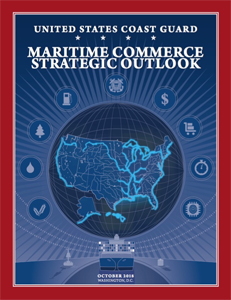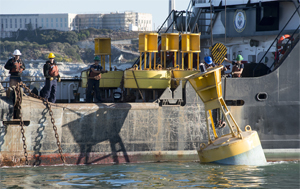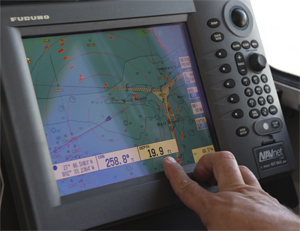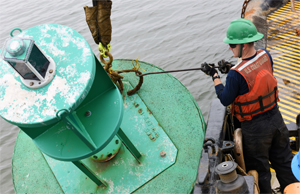The U.S. Coast Guard recently released its Maritime Commerce Strategic Outlook, a long-term vision to support and grow the nation’s maritime trade, in particular by integrating modern and traditional navigation tools.
The thinking is that with the expansion of the Panama Canal, more navigable days across much of the Arctic, and rising U.S. energy production — which means more barge and tanker traffic — the number and size of vessels transiting U.S. waterways will be increasing. According to Coast Guard spokeswoman Lt. Amy Midgett, additional commercial shipping coupled with an expanded use of U.S. waterways for renewable energy and aquaculture farming “could increase vessel density throughout the Marine Transportation System” and add transit complexity.
At the same time, Midgett explained, new navigation technology provides resources not available in the past. Thus, as a part of the Maritime Commerce Strategic Outlook, the Coast Guard is undertaking a systematic review of its policy on the use of aids to navigation, or ATON — which include some 50,000 buoys, beacons and ranges operated by the federal government — and the delivery of marine safety information.
“To make U.S. waterways safer, more efficient and more resilient, the U.S. Coast Guard is working with international, interagency and maritime stakeholders to better leverage technology to augment our existing system of physical aids to navigation,” Midgett said. Waterway management studies are being conducted throughout all regions of the country to obtain stakeholder feedback for determining the level of service required. “We are working to improve service delivery, enhance mariner situational awareness and increase waterway resiliency,” she said.
 |
|
Courtesy U.S. Coast Guard |
Modernizing aids to navigation
Technological advances have expanded the exploitation of natural resources while also boosting efficiencies in maritime trade. Innovations have led to a more interconnected and productive world, a complex world with new risks. For the Coast Guard to meet the challenges, the infrastructure used to assist maritime commerce needs to be up to date. According to the service, it has a responsibility to make sure that the nation’s waterways and maritime industry “employ innovative, state-of-the-art systems that ensure America’s competitiveness as a global trading partner” while also reducing risk.
Within the navigation section of the report, the Coast Guard has outlined its four top objectives:
Objective 1: Improve the nation’s waterways —
The report states that “the Coast Guard will leverage new and emerging technologies to ensure the MTS offers reliable and secure solutions to enduring navigational and operational challenges to maximize the safe and sustainable use of American ports and maritime resources.” Fixed and floating ATON, such as buoys, day markers and visual ranges, will continue to comprise a large part of the ATON system, with electronic aids to navigation (e-ATON) “increasingly expected to supplement the existing aids constellation in the future.” The service also indicated it hopes to accelerate the integration of these modern navigation systems.
 |
|
Crewmembers on the Coast Guard cutter George Cobb place a yellow buoy marking the center of the Fleet Week security zone in San Francisco Bay in October 2017. Fixed and floating aids to navigation will continue to comprise a large part of the Coast Guard’s ATON system. |
|
Courtesy U.S. Coast Guard |
Objective 2: Optimize maritime planning —
The report notes that maritime governance and planning are crucial to “minimizing conflicts among users,” enhancing predictability and providing other benefits. In particular, the plan includes a focus on developing and implementing “next-generation waterway system designs” to enhance mariner situational awareness, increase waterway resiliency, and improve information sharing with interagency partners and the maritime industry “to monitor industry’s emerging technology, such as autonomous systems.”
Objective 3: Recapitalize aging assets —
The Coast Guard says aging vessels and equipment jeopardize its capability to establish, maintain and repair beacons and buoys in America’s waterways. The report calls for more investment in modern assets to perform the ATON mission, including new vessels and information technology (IT) storage and data processing capabilities.
Objective 4: Streamline and update information systems —
The report notes that the maritime industry is investing extensively in IT systems and increasing its use of electronic condition-based monitoring of ships and equipment, as well as employing electronic certificates, electronic credentials and electronic navigation systems. Meanwhile, the age and increasing obsolescence of the Coast Guard’s marine safety, credentialing and navigation information systems can be an impediment and may “jeopardize the efficiency of the MTS as much as aging cutters, bridges, locks and silted waterways.” In response, the report says the service plans to initiate research and development and invest in modern information systems that facilitate the safe, secure and sustainable flow of commerce.
Of course, Midgett noted, the Coast Guard won’t be doing all of this alone. She pointed out that the service maintains strong working relationships with maritime stakeholder groups at the federal, state, local and tribal levels.
 |
|
A member of the Coast Guard’s ATON team for St. Petersburg, Fla., evaluates the condition of ports in the Tampa area in September 2017 after Hurricane Irma. One of the goals of the service’s new strategic outlook is to “promote the use of electronic navigation charts in lieu of paper charts where applicable, as long as conditions of accuracy, reliability and cybersecurity are met.” |
|
Courtesy U.S. Coast Guard |
“The service relies on these partnerships to maintain the safety, security and stewardship of U.S. waterways. Many of our missions depend on coordination with interagency stakeholders,” Midgett said. “We actively participate in the U.S. Committee on the Marine Transportation System and maintain robust partnerships with the Army Corps of Engineers and National Oceanic and Atmospheric Administration.”
Providers of maritime equipment are also part of the equation. As the Coast Guard implements the Maritime Commerce Strategic Outlook, it will keep manufacturers and other maritime interests informed of any recommendations or regulations that could impact them, Midgett said.
Jennifer Carpenter, executive vice president and chief operating officer at the American Waterways Operators (AWO), said her group was pleased to be able to provide input during the formulation of the strategic blueprint. “We commend the Coast Guard for its clear focus on the importance of keeping economically vital maritime commerce moving safely and efficiently,” she said.
Midgett said the Coast Guard is taking a careful approach to moving forward. Understanding the foundations of safe navigation will remain paramount for every mariner as the future of navigation progresses with each new technology advancement, she emphasized. “As has been the case throughout our 228-year history, the U.S. Coast Guard will only make decisions that enhance the safety and security of our waterways and the mariners who travel on them,” she said.
 |
|
Coast Guard Seaman Charles Maurer, a crewmember on the cutter Frank Drew, pulls in a buoy for maintenance on the James River in Newport News, Va., in February 2018. The Coast Guard aims to achieve optimal marking of the nation’s navigable waterways through “data-driven and risk-based methodology,” supplementing physical aids with electronic aids to navigation, or e-ATON. |
|
Courtesy U.S. Coast Guard |
In practice, that means any changes “will be thoroughly evaluated to ensure they maintain safety of life at sea” and make U.S. waterways safer, more efficient and more resilient. “The voluntary alternatives available for mariners to use, such as electronic charts, electronic publications and electronic charting systems, demonstrate the U.S. Coast Guard is embracing technology to create additional navigation tools to assist mariners in compliance with carriage requirements,” Midgett said.
One of the specific elements included in the document is the goal to establish the “paperless bridge” — in other words, the replacement of cumbersome maps and paper documents, which can go out of date or become damaged in use, with authoritative electronic sources.
Carpenter said the AWO looks forward to continuing to work closely with the Coast Guard and other federal agencies with roles in the administration of the Marine Transportation System “to build upon and implement this vision for enabling American economic competitiveness.” Modernized navigation and information systems will be at the heart of the effort.

